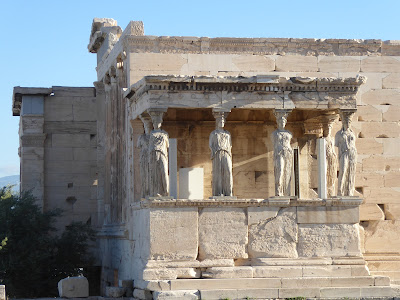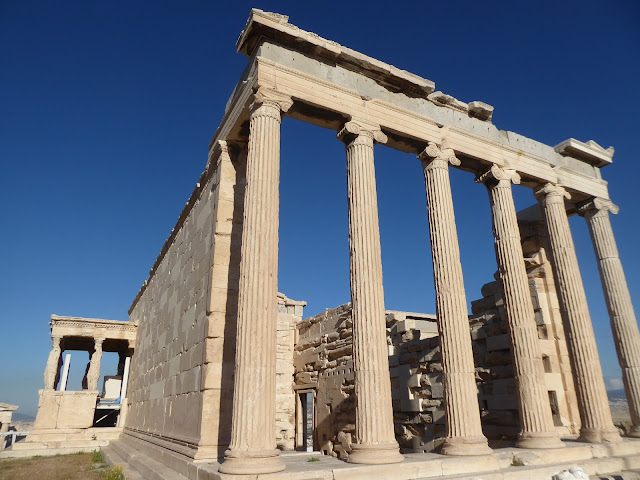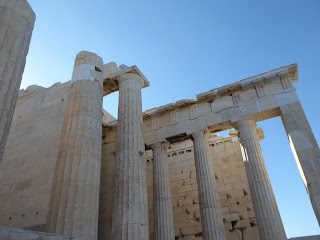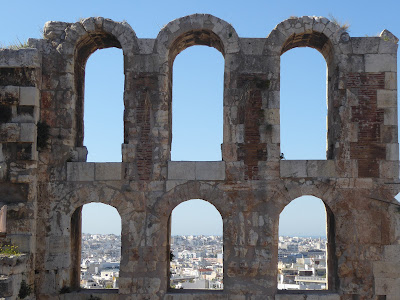Now the Acropolis is clearly one of those must do sights. However, it is also one of the most disappointing actual experiences among such sights. For three reasons. I will come onto the other two later, but the first is tourists. Or rather tour groups. So, I did the only thing you can do to make it a tolerable experience which is to get up there before they arrive. The Acropolis opens at 8am and I was there at 5 past. (Arriving before opening is not cool - makes you look obsessive).
And if you get up that earl, it doesn't do to dawdle. So although there are a number of interesting ruins on the way up, I gave them only a cursory glance (and quick photo or two). So don't worry, what you see here is only a brief glimpse. You will see them again on the way down, later in this entry.
But eventually you reach the impressive entrance, the Propylaia. This is in remarkably good nick all considered. What you have to consider is that it got turned into an archbishop's residence, a Frankish Palace and a Turkish fortress, was struck by lightning in 1645 even before the whole place including the Parthenon was blown up Venetians when the Turks were using it as an arsenal in 1687.
So that in my view is the second reason that the Acropolis is a disappointing place to go in, if you are me. I just can't think how close we were to having so much more of it. It lasted quite well for over a thousand years, but got hit by warmongers and religious zealots. Frustrating.
As you can see above, even early in the morning one is not alone, but the tourists who arive on their own steam are not oppressive in numbers.
And you do get a great view from the Propylaia.
To the right of the entrance is the small reconstructed Temple of Athena Nike. This a highly photogenic little gem, built in marble with 4m tall columns but sitting on a 9m bastion, which gives it presence.
As I say, the Propylaia is in surprisingly good nick given what its been through, which includes a degree of roofing.
Ok, and now for the third reason this is such a disappointing sight. Its still as much of a building site as it was 30 years ago, and there is no sign the restoration will be finished any time soon. Probably not in my lifetime t this rate of progress. Or non-progress. It was supposed to have been restored in time for the 2004 Olympics. But just as on my last visit, it still has a crane in it and loads of scaffolding. You can't deny it detracts from the image.
Now I would be the first to say one shouldn't rush restoration. But this is the opposite of rushing. Its not even fair to say they are working slowly. Because basically they aren't working. And you can't blame austerity measures as it has gone on for much longer than that. Indeed as my travels around the City showed time and time again, massively late delivery of projects is a repeated fact and it goes back over a 100 years. It's just impossible not to consider it a national trait.
It wouldn't be fiar to say there was no activity at the Acropolis. There was a small squad of soldiers doing some vital marching up and down. But that's it.
 |
| Up early enough to even catch the moon. |
 |
From the Acropolis one can of course look down, as the Ancients would have done, on the Temple of Olympian Zeus...
.. the Forum
..the Temple of the Winds
Now although the Temple of Athena Nike is photogenic, nothing quite beats the Erechtheion. Its every bit as clever as the Parthenon (renowned fr its perfect dimensions, slight curves etc) given its built on several levels as its on a sloping site. And of course it has the Caryatids - the columns in the form of maidens. Reproductions stand here as the originals are in the Acropolis Museum now, to avoid further weathering and Athenian pollution.
Below is the Erechtheion from the other, less photographed, side.
So back now to the Propylaia having explored the site quite thoroughly, and the tour groups with their nattering guides starting to build up. Its the coach parties that ruin (no pun intended) places like this. Firstly because they are noisy, and secondly because they cluster rather than spread out. But also just because they can be delivered in large numbers.
This gives some idea of what the ceiling would have looked like, but of course they would have been brightly painted. It is ironic that the shining purity of the white marble that we admire so much appealed to the Greeks because it took paint so well.
So time to go, forcing oneself down against the by now semi-constant stream coming in the opposite direction.
The Beule Gate, below, is an almost recent discovery. Although built in 267 AD as a fortification after Athens was sacked by a German tribe, the Heruli, it wasn't rediscovered until 1852 by a French archaeologist, Ernest Beule. Even in 267 this gate was built out of the destruction of an earlier Choregic monument. Recycling.
So back to the thetares at a more leisurely pace while the hordes pass me going up. First the smaller, but more in tact Roman Theatre of Herodes Atticus. It is still used for concerts.
Now there are also on the slopes a series of grave markers and other marbles. One of the more bizarre features, to our eyes, are the number of these that are entirely unadorned and featureless, apart from a careful carving of male genitalia on them. Imagine a gravestone with nothing but a cock and balls on them. But then this wasn't seen as something erotic, but more as good luck and sign of regeneration.
These are the remains of a stoa, essentially an ancient shopping centre.
And now back to the Greek Theatre of Dionysus, although even this Greek theatre is actually Roman, in the sense that it was renovated by the Romans. But here is where all those plays by Euripides, Aeschylus, Aristophanes and Sophocles that I read at school and which are still regularly revived first made their debuts. Could host an audience of 17,000.







































































































































































No comments:
Post a Comment